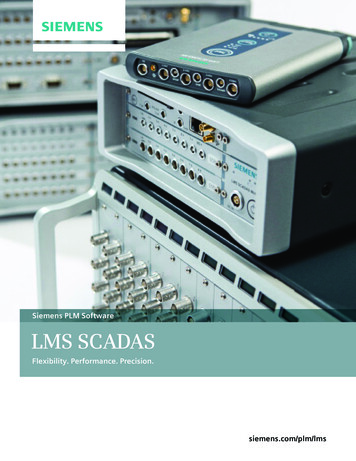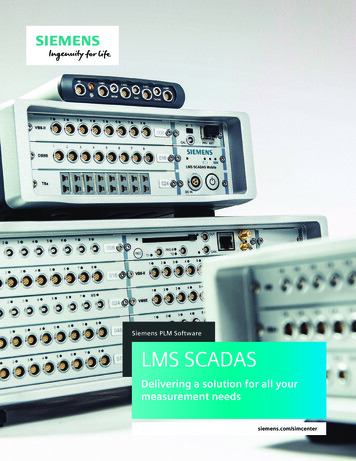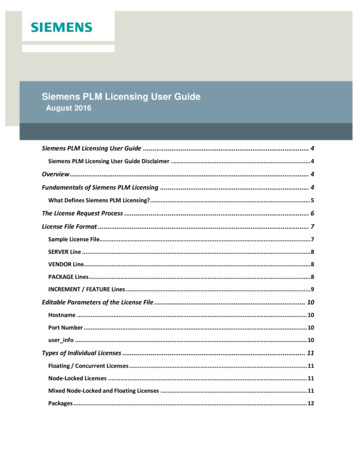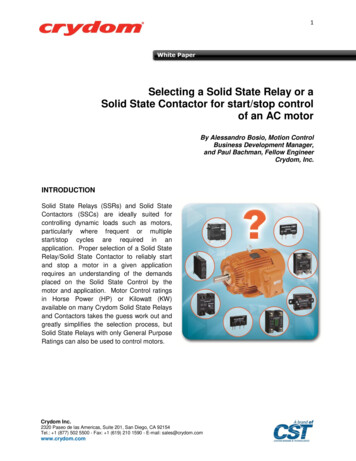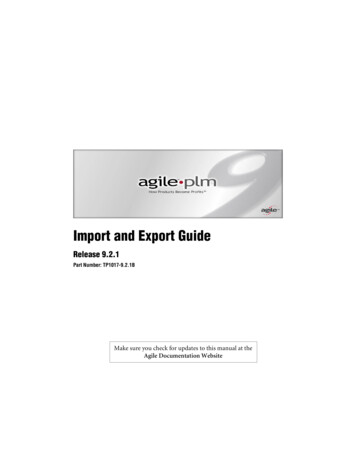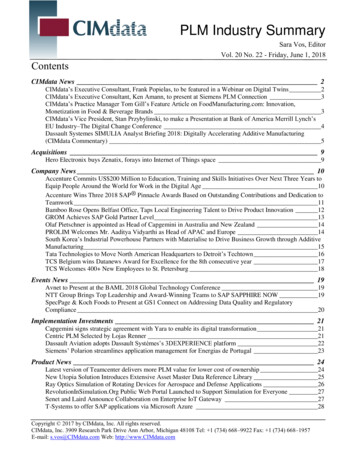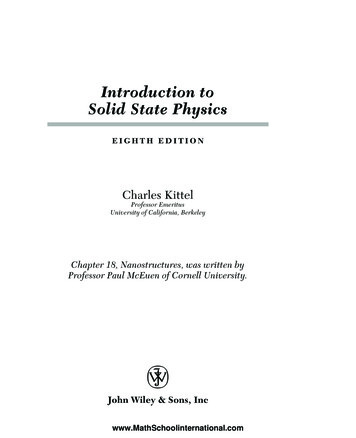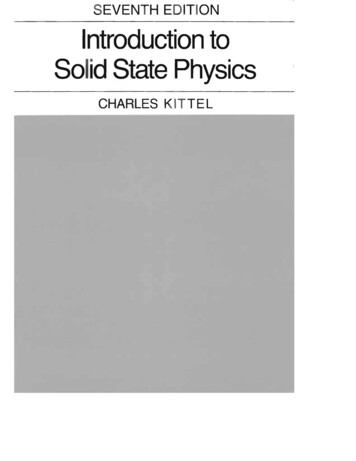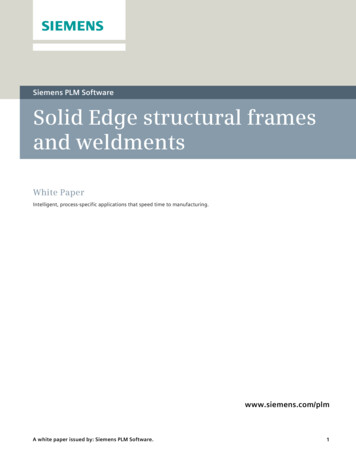
Transcription
Siemens PLM SoftwareSolid Edge structural framesand weldmentsWhite PaperIntelligent, process-specific applications that speed time to manufacturing.www.siemens.com/plmA white paper issued by: Siemens PLM Software.1
White paper Solid Edge structural frames and weldmentsContentsSolid Edge structural frames and weldments . 3 Solid Edge Structural Frames . 4 Creating the frame skeleton . 4 Building the 3D frame . 4 Create drawings with cut lists . 5 Solid Edge Weldments . 6 Creation and selection of the weldment . 6 Surface preparation . 6 Weld bead creation . 7 Machining . 8 Drawings and documentation . 9 The Solid Edge advantage . 10 Conclusion . 11 A white paper issued by: Siemens PLM Software.2
White paper Solid Edge structural frames and weldmentsSolid Edge structural framesand weldmentsSolid Edge software includes two process-specific applications designed specifically to speed the creation of rigidframe structures and weldments, both of which are commonly required for process equipment and mechanical machinery. Solid Edge Structural Frames and Solid Edge Weldmentsare part of the core design capabilities of Solid Edge andfeature the same user-friendly process-oriented workflowsthat have made Solid Edge the most intuitive and productivesolid modeling program available.Solid Edge Structural Frames and Solid Edge Weldmentsincorporate industry intelligence and use the terminologycommon to their disciplines. Embedded engineering processknowledge, along with structured workflows, help youdesign frames and weldments much faster than with generalpurpose CAD modeling tools. Streamlined modeling commands are tailored to the unique needs of the tasks formaximum modeling speed.A white paper issued by: Siemens PLM Software.Solid Edge Structural Frames and Solid Edge Weldments arefully associative with Solid Edge assembly, part modeling anddrafting capabilities. Because these applications are corecapabilities of Solid Edge, users can leverage the exclusiveSolid Edge cPDM and design management capabilities integrated directly into the CAD system to enhance collaboration,speed decisions and ensure that users are always workingwith the most current version of a design.Solid Edge Structural Frames and Solid Edge Weldments acttogether to provide a workflow that speeds the design,validation and documentation of welded frames, makingSolid Edge the best choice for machinery and process equipment design. This paper explores how these applications areused and how much time they save compared to traditionaldesign methods for welded frames.3
White paper Solid Edge structural frames and weldmentsSolid EdgeStructural FramesSolid Edge Structural Frames is a process-specific workflowthat helps users develop rigid frame structures. An intuitiveinterface guides a user through the process of creating a 3Dsketch of the frame skeleton, modifying default features,applying standard structural cross-sections and then automatically generating a 3D solid model of the frame.In addition to creating path segments from 2D sketches,you can also use edges and other geometry from 3D partsin the assembly. You also can build frames that have morethan two frame members joined at a single vertex, choosingwhich of several possible solutions you want to use formitering or cutting each of the frame members.Creating the frame skeletonThe Structural Frames workflow is initiated from the assembly environment. During this step, you create the skeleton,which delivers a fully associative path for the frame sectionto follow. This step uses the same tools that have beendeveloped for the Solid Edge XpresRoute application,which let you specify these paths quickly by defining 3Dvariational sketches using specialized modeling aids, suchas OrientXpres.Building the 3D frameOnce a full or partial frame skeleton has been created, clickthe frames button. This command lets you build the frameunit by choosing segments of the frame skeleton andselecting specific cross-sections to apply to those segments.OrientXpres is an interactive design aid that assists indrawing the 3D lines and arcs that the frame members willfollow. Both straight and curved frame paths are supported,so you can define frame components to be linear, curvedor bent. As you draw line or arc segments, you can useOrientXpres to lock the orientation of the segment parallelto an axis or plane.You can also associatepath segments toexisting assemblygeometry using standard Solid Edge relationships, such as parallel,perpendicular andcolinear. As with 2Dsketches, you can define the size of the segments usingdimensions, variables or other constraints to set relationships, such as making two frame members equal in length.A white paper issued by: Siemens PLM Software.After clicking on the desired path geometry, you can eitherselect a cross-section from the recently used pulldown listin the SmartStep ribbon bar, or browse the standard librarycomponents to specify the frame component type and size.Solid Edge is delivered with a complement of frame sizes inits Standard Parts application, with many more available inthe optional Solid Edge Machinery Library. Solid Edgesupports the most common cross-sectional shapes, as wellas many others such as T, hexagonal, Z and flats. Most ofthe major standards (for example, ANSI, DIN, ISO, GB, JIS)for frame components are supported. You also can add yourown custom components to the library (see Solid Edge Helpfor details on how to do this), and use them in exactly thesame manner.After selecting the relevant cross-sections, Solid Edgeautomatically creates the 3D model of the frame by applying those sections to the chosen path segments and usingthe end treatment options specified in the initial framedialog. You have a number of different end conditions tochoose from – miter, butt1, butt2 or none. The miter andnone options are self explanatory. With a butt1 condition,the longest member will be trimmed against (the shortest4
White paper Solid Edge structural frames and weldmentsmember will have material removed to suit). A butt2 condition is the opposite, with the shortest member beingtrimmed against. You can mix and match frame componentsizes and shapes and their end condition treatments; anycombination is possible.At this point, you can either click the finish button onSmartStep, or make any necessary edits to the path step,frame cross-sections or frame end conditions for the set ofcomponents you have just created. If you finish, you canthen continue to add more frame members to the pathgeometry. Subsequent frames will be trimmed againstexisting frame components, giving you the ability to mixand match sizes and shapes of frame components in anycombination.Create drawings with cut listsAs with all process-specific functionality in Solid Edge, fullsupport is provided for creating drawings of 3D frames. Youcan automatically create a parts list that includes cutlengths for each component and choose how you want toorganize the list for downstream viewers in manufacturingor purchasing. Solid Edge also supports the concept of“rough cut” sizing, allowing you to specify an amount thatwill be added to the exact length of frame. For example, theexact length of a frame may be 36 inches, but you need theparts list to display 36 inches or the “rough cut” length. Inthis case, you simply specify a rough cut value of a half inchto be added to the exact length of each frame component.A nice feature of this workflow is the built-in support forautomatic positioning. As you continue to add componentsto the overall frame, those individual components willanalyze any existing, adjacent frame components to determine their correct location and orientation. If the automatically chosen position is incorrect, you can quickly shift thecomponent using the n key to rotate in 90º increments, orthe arrow keys to shift upward, downward, left or right.You can also select frame components and use standardSmartStep methodology to click back through any of thecreation steps to edit a frame that you have already created.In this way, you can add or remove path segments, selectnew frame cross-section types or sizes, or change endtreatments globally (for the whole frame) or locally (for asingle vertex). After making edits, the frame will immediately be recomputed to show the changes.A white paper issued by: Siemens PLM Software.5
White paper Solid Edge structural frames and weldmentsSolid Edge WeldmentsThrough close cooperative work with our customers andtalking to welding engineers, we have developed Solid EdgeWeldments to provide process-driven tools to speed uptime-to-manufacture. Solid Edge Weldments complements(but is not limited to) Solid Edge Structural Frames byproviding a process-specific workflow for the efficientconstruction of weldments, using a frame assembly document as input. A weldment is started directly within a SolidEdge assembly where process-specific tools are used to addtrue weldment information, adding surface preparationfeatures, defining weld bead features and weld characteristics, and specifying final post-weld features. Weld bead andmachining operations and weldment operations are organized in the native assembly tree within EdgeBar.Surface preparationMany welded joints use weld preparation to strengthenthem. On thin gauged materials such as sheet metal, up toabout 3mm thick, a simple gap of about the material thickness is usually all that is required. On thicker materialsdifferent types of weld preparation are normal; ‘V’, ‘J’ and ‘U’preps are used depending on the material and the jointtype. Solid Edge provides assembly feature tools, such aschamfer, cutout and swept cutout to create weld preparation details on the edges where parts are to be weldedtogether. These do not affect the parts in the original frameassembly document.Creation and selection of the weldmentThe process begins by marking a Solid Edge assembly asa weldment using the Weldment Assembly command.Because you remain in the assembly, you maintain all theadvantages such as color, styles, configurations, productstructure and managed data in a single file. The weldmentis assigned properties for bead material, style and density.These properties are applied to the weld as they are created. By assigning a material density, weight is automaticallyadded to the assembly, providing accurate mass calculations. Companies are able to use the weld bead masscalculations to help estimate costs (many companies estimate the cost of welding based on weld bead mass). Assoon as the assembly is marked as a weldment, a processspecific toolbar is presented, for weld preparation, addingweld material and post-weld machining operations.A white paper issued by: Siemens PLM Software.6
White paper Solid Edge structural frames and weldmentsWeld bead creationSolid Edge provides many tools to easily create the weldbead material depending on the weld type required andjoint preparation.Fillet welds The most common type of weld is the filletweld. Following a simple process, all you have to do ischoose the two faces that aregoing to be welded together.Solid Edge automatically createsthe familiar triangular shapedweld bead associated with thisweld type; predefined parametersfor each leg length and offset,size and style are used.Customized welds Not all welds are simply triangular inshape; some beads need to represent a specific crosssection, either because of the weld specification or preparation type. Assembly feature tools – protrusion, revolved andsweep protrusions – are available so that users can definetheir required weld bead cross-section.Groove weld For joint types withshaped weld preparations, the grooveweld bead provides great flexibilitywhereas other methods do not supportsuch a bridging gap. You can quicklyadd weld beads to components withcomplex boundaries or weld preparation on bothsides of the joint. The process for creating a groove weld issimple – choose the faces to apply the weld, select theboundary where the weld preparation is to be containedand the groove weld is complete. Additional extent optionsallow you to control how the groove weld extends along theweld, or cross-sectional profile.A white paper issued by: Siemens PLM Software.Compound weld Many welded joints consist of multipleweld beads or runs as they are sometimes known, whichoverlay each other to strengthen a joint. The compoundweld bead command allows designers to add welds on topof other weld beads,and then label them.When a compoundweld is labeled, it canthen be extracted onthe drawing toprovide detailedannotations ondrawings.Stitch weld Where strength or gas tightness is not a priority, stitch welds are used to save time and materials. TheStitch Weld commandprovides a dedicated toolto apply stitch welds tojoin components. Optionsallow you to control thestitch length, gap size,style and offset values forperfect control.Mirror and patterning To help speed up the weldmentprocess, weldments can be patterned or mirrored to otherareas of the weldment.Weld label The weld label enables youto define the weld symbol attributesyou want. Additional weld annotationsare added to the 3D solid weld bead.The weld label is used to build a weldsymbol, to define the weld specification and add it to the 3D model.Details such as weld process, jointtype, weld bead type and
design frames and weldments much faster than with general-purpose CAD modeling tools. Streamlined modeling com-mands are tailored to the unique needs of the tasks for maximum modeling speed. Solid Edge Structural Frames and Solid Edge Weldments are fully associative with Solid Edge assembly, part modeling and drafting capabilities. Because these applications are core
